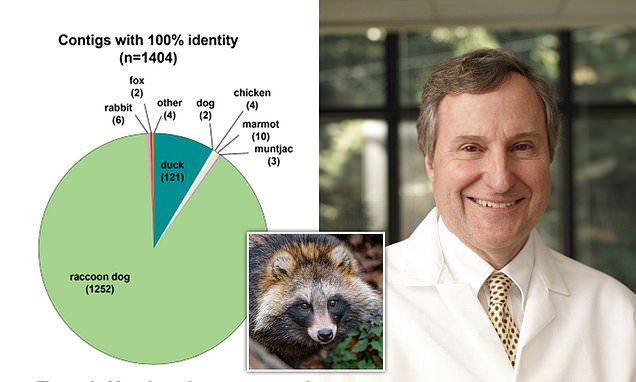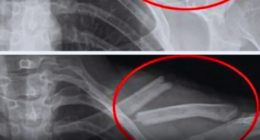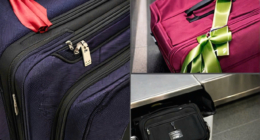Scientists have released a new study indicating that raccoon dogs were sold at the Huanan wet market in Wuhan where the first cases of COVID-19 were detected, further supporting the theory that the virus originated from wildlife. The study’s researchers claim that raccoon dogs made up more than 80% of DNA and RNA detected in a cart sample that tested positive for COVID-19, adding that this discovery heavily favors the natural spillover theory. Other mammals such as the Malayan porcupine, amur hedgehog, masked palm civet, and hoary bamboo rat also had positive COVID-19 specimens, but raccoon dogs were the most prevalent. In contrast, some scientists, such as Dr. Ebright and Dr. Quay, argue that the new report does not provide any new information that permits new conclusions and that the report’s coverage risks undermining investigations of COVID-19’s origin. However, Dr. Garry, a microbiologist at Tulane University, believes that this study adds a lot of new information and puts raccoon dogs “at the very scene of the crime.” GISAID, the database that published the report’s data, accused the study’s researchers of breaching the database’s terms of use, while researchers maintain that they have not breached these terms.
Experts claim that a recent study suggesting that Covid-19 spillover to humans from raccoon dogs is ‘the strongest evidence yet’ that the virus emerged naturally omitted key information that undermined its findings. The report, published online on Monday, found DNA from raccoon dogs in the same location at a wet market in Wuhan where genetic material from Sars-CoV-2 was clustered in 2019. The research team concluded that this finding ‘contributed to the large body of evidence supporting a natural origin’. However, all of the DNA samples from raccoon dogs tested negative for Covid via PCR test, according to experts. This omission raises growing concerns about the report’s reliability, as its authors include scientists who shut down debate about the lab leak theory.
Researchers identified stalls in the southwest corner of the market where Covid is most prevalent. Racoon dogs made up more than 80 percent of Covid samples that researchers could identify a species for with 99 percent confidence or more. Dr Steven Quay, a microbiologist who has spent the past two years investigating Covid’s origin, said the report’s authors were ‘untruthful’ due to their willingness to omit important information. The lead author of a February 2020 paper, Dr Kristian Andersen, was part of the research team for the current study. The earlier paper, titled ‘Proximal Origin’, was designed to squash the theory that Covid may have escaped from the Wuhan Institute of Virology (WIV). Emails revealed earlier this month showed that Dr Andersen was prompted by former White House doctor Anthony Fauci to publish the paper, despite both experts privately expressing concern that the virus showed hallmarks of human engineering.
The new research is still pending peer review and researchers used data that was uploaded to the Global Initiative on Sharing Avian Influenza Data (GISAID), an international hub containing viruses’ genetic information.
According to a recent study, researchers have found genetic material from raccoon dogs and Covid from the same southwest corner of the Huanan Seafood Market in Wuhan, the epicenter of the Covid-19 pandemic. The Chinese Centers for Disease Control and Prevention (CCDC) had previously kept this data under wraps. Researchers were able to access and study the swab samples for the first time. The study claims that the detection of Covid and raccoon dog specimens in the same place is too eerie to be a coincidence, but it does not prove that the animals had Covid, only that the virus existed on the same surfaces.
Dr Steven Quay accused the research team of using an imperfect testing method to detect the Covid genetic material, and he called the paper ‘completely dishonest’ in saying it was evidence for a natural spillover. The raccoon dog sample PCR tested negative for Covid, but it was positive when next-generation sequencing was used. However, the CT score of the raccoon dog samples that tested positive for the virus was too high to be reliable, and the reliability of a PCR test is the equivalent of around 40 CT.
Dr Quay explained that the researchers had to reach a CT score into the thousands to find a raccoon dog sample that was positive for Covid. He also mentioned that the specimens that did test positive for the virus via PCR were ‘mostly human’. Dr Simon Clarke, a microbiologist, said that the researchers should have highlighted the negative PCR test result in their report. He also said that scientists should keep an open mind and push in either direction.
Raccoon dogs are known to act as intermediate hosts of the virus, meaning they catch pathogens from the wild and harbor them without falling ill themselves. They pose a risk of spreading viruses to humans or any other animal they come into contact with. However, the study does not prove that raccoon dogs had Covid-19, as it only shows that the virus existed on the same surfaces.
The recently published report on the origin of Covid-19, which claimed that the virus spillover to humans from raccoon dogs, has been criticized by experts. The report found genetic material from raccoon dogs in the same location at the Wuhan wet market where genetic material from SARS-CoV-2 was clustered in 2019. However, experts have claimed that the report is underwhelming and does not provide any new information that would allow for new conclusions to be drawn. Dr. Francois Balloux, the chair of computational biology at University College London, said that the report confirms the presence of wild animals, including raccoon dogs, at the Huanan market but does not confirm that the animals themselves had Covid-19. This means that the report does not improve our understanding of the early stages of the pandemic.
Dr. Richard Ebright, a molecular biologist at Rutgers University, called the report a “nothing burger” as it contains almost no new information that permits new conclusions. Similarly, Dr. Jesse Bloom, a virologist at the Fred Hutchinson Cancer Center in New York City, expressed concerns about the time when the samples were collected. He pointed out that human SARS-CoV-2 infections started in Wuhan no later than November 2019, so environmental samples collected in January 2020 may not provide conclusive answers about the origin of the outbreak.
Dr. Balloux also warned that the drama surrounding the report risks undermining serious investigations of the origin of Covid-19. He expressed concern that Chinese scientists may change their minds about sharing their raw data with the world. According to Dr. Richard Ebright, the report did not provide any new evidence, while Dr. Jesse Bloom suggested that knowing more about animals could help trace the supply chain, which is a valuable line of investigation.
The report’s authors include some figures who were embroiled in controversy when Dr. Fauci’s emails from early in the pandemic were made public. Dr. Andersen, one of the authors, wrote in a February 2020 email that the unusual features of the virus make up a really small part of the genome, so one has to look really closely at all the sequences to see that some of the features potentially look engineered.
In summary, while the report confirms the presence of wild animals, including raccoon dogs, at the Wuhan wet market, it does not provide any new evidence to support the theory that the virus spillover to humans from raccoon dogs. Experts have criticized the report for its lack of new information and warned that the drama surrounding it risks undermining serious investigations of the origin of Covid-19.
Study Debunks Wuhan Lab Leak Theory
New research investigating the origin of the COVID-19 virus has dismissed the theory of a lab leak, instead pointing to natural spillover. The study, carried out by the Chinese Centers for Disease Control and Prevention, was published in November 2021 and has been reviewed by 24 international experts. The report found evidence of genetic material from raccoon dogs and COVID-19 on surfaces and in cages of the Huanan Seafood Market in Wuhan, where animals were sold for meat or fur. Although the raccoon dogs acted as intermediate hosts of the virus, the study does not prove that the animals had COVID-19, instead showing the virus existed on the same surfaces.
Expert Analysis
Dr. Robert Garry, a microbiologist at Tulane University, dismisses the theory of a lab leak, claiming that there is no lab leak scenario consistent with the data. He argues that Dr. Quay and Dr. Ebright are ‘motivated by politics and an anti-science agenda,’ and that there is no reason not to trust this data, as it is internally consistent. Dr. Garry notes that the next-generation sequencing (NGS) testing dismissed by Dr. Quay would be more accurate than a PCR test because the samples collected by the CCDC were partially degraded. He adds that the report adds a lot of new information and puts raccoon dogs ‘at the very scene of the crime.’
Early discussions about the potential synthetic nature of the virus
Dr. Garry was also involved in discussions early in the pandemic about the potential synthetic nature of the virus. On a call with Dr. Andersen and Dr. Fauci, the lab leak theory was allegedly discussed, with the objective of dismissing it. However, Dr. Garry claims there is no scenario consistent with the data to support a lab leak theory.
A New Line of Investigation
New studies are pointing to a natural spillover of COVID-19 at the Huanan wildlife market, where positive swab samples of floors, cages, and counters track the virus back to stalls in the southwestern corner of the market, where animals with the potential to harbor COVID-19 were sold for meat or fur. While the debate rages on as to whether the outbreak began with a spillover from wildlife sold at the market or leaked out of the Wuhan lab just eight miles away, the new research provides a valuable line of investigation.
Timeline of the Study
The study began when Dr. Florence Débarre, from the French National Center for Scientific Research, came across the data the day it was published, March 4, 2022. The researchers downloaded the data, hoping to investigate it as part of their search for COVID-19’s origin. Researchers learned later that the data was uploaded on June 22, 2022, but not released to the public. It was also used for a pre-print report revealed by Chinese scientists in February 2022. It was removed from the database on March 11, but the research team had already downloaded it. GISAID accused the team of breaching the database’s terms of use by acquiring the data, but the team argues that the data was already public.
Conclusion
While some scientists argue that the study does not provide new information, Dr. Garry insists that it presents new strong evidence that supports the natural spillover theory. He believes that the lab leak theory should be put to rest once and for all. The report underscores the need to balance the urgency of sharing genomic and associated metadata and its quality to aid public health decision-making.
The CCDC plans to re-upload the data after its own review, though no timeline has been given. The researchers deny any breach of terms and have no intention to breach them. Positive Covid specimens were found in mammals such as the Malayan porcupine, amur hedgehog, masked palm civet, and hoary bamboo rat, but raccoon dogs made up more than 80% of DNA and RNA detected. The study’s authors believe this supports the natural spillover theory and that wildlife was the source of the first Covid infections in humans.
Don’t miss interesting posts on Famousbio









